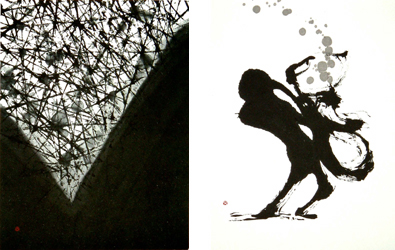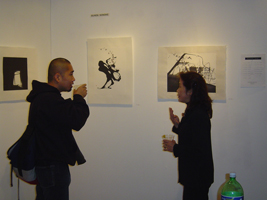
November Exhibition 2004
November 3rd, - November 20th, 2004 Gallery Hour |
 |
|---|
The Seventh Exhibition at the NYCoo Gallery is the solo exhibition of Sonoke Bunenfs Heart Calligraphy. This is the fourth New York show for this Kyoto artist presenting her Shinsho (Heart Calligraphy) of her own naming. The following is an explanation of Shinsho from her numerous articles and interviews. This may be presumptuous, but Shinsho is a word of my own creation. I named it for the three-part relationship consisting of the heart (meaning) of what the kanji (Chinese character) holds, the heart of the calligrapher, and the heart of the viewer. Kanji incorporates many meanings. Each of the meanings evokes various images. There are instances when images come to mind in looking at a kanji, and other instances when a certain scene ties in with a specific kanji. Most probably, souls must dwell in these characters nurtured through an eternity of time. In that case, rather than inquire into the source of the characters, I thought it possible to breath new life into the contemporary character through my own images. I now find myself completely involved with Shinsho. In viewing materials from past shows, many of the selected kanji were hieroglyphic characters: echerry blossom,f emoon,f ebird,f eant,f estring,f ewater,f erain,f ewind,f ewoman.f Cherry blossom is written as if in full bloom using sumi black and noutan dark and light. Characters such as elifef and epulsef are also written. There are characters such as elovef which defies shape. Needless to say, there is currently a kanji boom here in America. From T-shirt to tattoos of sports athletes, there is a wide interest in kanji among young people both male and female alike. Kanji fascinates people whether they understand it or not. Meeting Americans who do calligraphy, I am told they do it for meditation. Recalling the influences on Mark Twomblyfs White Paintings of the e40s, Franz Klinefs Action Paintings of the e50s, and Brice Mardenfs recently works, calligraphy is not the artistic expression of the cultures that have historically used kanji but comes to be seen as a global genre for self expression. Returning to Shinsho, the purpose of art always intends to move people metaphysically, therefore there seems no need to put eheartf next to ecalligraphy.f However, there must be a strong intension in the naming. She must be taking a critical attitude toward the existent ecalligraphy worldf by drawing a line to mark herself apart. She is making a conscious choice. So then, to what does this eheartf point. What is the heart of echerry blossom?f This writer wonders whether this calligrapherfs generation can transcend the sentiments of cherry blossoms symbolizing the suicide pilots of the kamikaze forces and Yamato damashi (Japanese spirituality as utilized by the political right in World War II)? In contrast, elifef as a work has surface tension in the black and white opposites that makes one reaffirm the black of the sumi and the white of the paper. ePulsef invites the viewer into an unknown world of the calligrapher own volition. Hieroglyphics that denotes physical things has a tendency to become merely simplified illustrations. Characters that have more abstract meanings such as elifef and epulsef seem to allow for expression that are artistically deeper and more spiritual. In actually seeing the works of Sonoke Bunen, there is a need to consider this point of view. What new works will she show this time? I await the opening of the exhibition with my eheart.f
|
||
Gallery writer: Hitoshi Nakazato |
||
